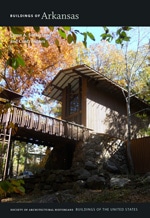The forty-acre property of St. John Seminary in Pulaski Heights was referred to as a “complete wilderness” when construction began in 1915. Although the property is now surrounded by residential development, the campus remains partially wooded with large expanses of green space. In 1908, Bishop John B. Morris opened a Catholic college, named Little Rock College, in downtown Little Rock, and in 1911 St. John Seminary became a part of the college. Increased enrollment required more space for the students, and in 1916 the college and the seminary moved to this site. Little Rock College closed in 1930 following the economic crash of 1929. By 1967 the number of seminary students was so few that the seminary closed too. The campus now serves as a Catholic training center and retreat. The center’s buildings are arranged around an oval-shaped green space, and the four early structures (Morris, Byrne, and Fitzgerald halls, and a gymnasium) designed by Blaisell are Collegiate Gothic in style. Morris Hall (1916) is a three-part building with an elaborate stone frontispiece. A chapel by Thomas Harding Jr. was added to the rear of the hall in 1951. The chapel’s twelve stained glass windows depict saints who were associated with priestly life and missionary work. Fitzgerald Hall (1916) was the science building, and a series of cartouches on the facade symbolizes medicine, engineering, and art. Byrne Hall initially was the refectory for the seminarians, and its exterior is embellished with gargoyles. The former gymnasium (1916) included apartments for faculty members and caretakers; the building later had other uses.
You are here
St. John Catholic Center (St. John Seminary)
If SAH Archipedia has been useful to you, please consider supporting it.
SAH Archipedia tells the story of the United States through its buildings, landscapes, and cities. This freely available resource empowers the public with authoritative knowledge that deepens their understanding and appreciation of the built environment. But the Society of Architectural Historians, which created SAH Archipedia with University of Virginia Press, needs your support to maintain the high-caliber research, writing, photography, cartography, editing, design, and programming that make SAH Archipedia a trusted online resource available to all who value the history of place, heritage tourism, and learning.















